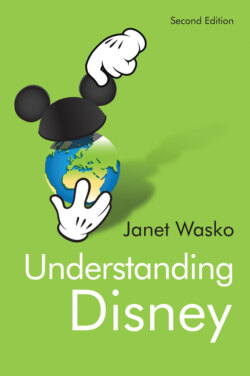Читать книгу Understanding Disney - Janet Wasko - Страница 17
Hollywood’s Horatio Alger
ОглавлениеIn spite of the company’s small size, the Disney legend grew to become larger than life. The company’s success was magnified because of the widespread popularity of its products, as well as the abundant praise heaped upon its leader. Bryman describes Walt Disney as one of those rare charismatic leaders “who dream up a vision about the need for a product, attract others to that vision and build the organization into an enthusiastic group of adherents.”27 Bryman further characterizes him as extremely ambitious, with a perpetually positive attitude and a strong belief in hard work and high-quality products.
But even the most laudatory biographies point out that Disney was also authoritative, moody, and demanding. Some of his employees called him a benevolent dictator and reported various scare tactics that he used to get his way. The more critical histories reveal that “Uncle Walt” (as he became known in later years) was extremely controlling and obsessive in various ways.28
There is no doubt, however, that Disney’s attributes included a “remarkable capacity to sell his product and himself.”29 He was especially adept at projecting his own image as someone who had become successful through hard work and perseverance. The press picked up his story and ran with it, repeating endlessly the saga of “the Horatio Alger of the cinema” and the self-made-man image that Disney cultivated. In 1934, Fortune observed that “Enough has been written about Disney’s life and hard times already to stamp the bald, Algeresque outlines of his career as familiarly on the minds of many Americans as the career of Henry Ford or Abraham Lincoln.”30
In spite of his image as a talented artist, Disney actually did little drawing after 1924, when he started working with Ub Iwerks.31 Disney is reported to have been more than a bit frustrated when asked to sign autographs, as he struggled to duplicate the famous Disney signature that the public came to recognize and expect. However, most accounts agree that Disney’s talent was in story editing and development; he seemed to have an innate sense of what would entertain the public and an ability to communicate his ideas to his staff.
Above all, Disney was committed to mass culture. He explained, “I am interested in entertaining people, in bringing pleasure, particularly laughter, to others, rather than being concerned with ‘expressing’ myself or obscure creative impressions.” His attitude, as well as his products, were well-suited to the era described above. For Disney’s products incorporated elements of other commercialized forms of entertainment and mass culture: “music, mischief, dance, comedy and heroic melodrama” drawn from popular music, vaudeville comedy, and dance.32
Disney’s driving passions have been summarized especially well by Watts:
The imperatives of success and mass culture always directed Disney’s path. From the earliest days of his career, he repeatedly confessed the great passions of his life: he was in love with his work and in love with the idea of entertaining a mass audience. His meteoric rise in the 1920s and early 1930s had made him a dynamic success story and a wildly popular entertainer for millions of American consumers.33
